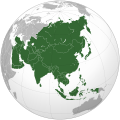еҚ°еәҰиӯҳеӯ—зҺҮ еҚ°еәҰиӯҳеӯ—зҺҮпјҲиӢұиӘһпјҡliteracy in IndiaпјүжҳҜдҝғжҲҗи©ІеңӢзӨҫжңғ經жҝҹйҖІжӯҘзҡ„й—ңйҚөеӣ зҙ гҖӮ[2][3]еҚ°еәҰзҡ„иӯҳеӯ—зҺҮе·Іеҫһ1947е№ҙе®ЈдҪҲзҚЁз«ӢжҷӮзҡ„12%еўһй•·еҲ°2011е№ҙзҡ„74.04%гҖӮ[4]йӣ–然йҖҷжҳҜеҖӢеӨ§е№…еәҰйҖІжӯҘпјҢдҪҶд»ҚдҪҺ於當е№ҙдё–з•Ңе№іеқҮиӯҳеӯ—зҺҮж°ҙе№іпјҲ84%пјүгҖӮи©ІеңӢж–ј2011е№ҙйҖІиЎҢзҡ„дәәеҸЈжҷ®жҹҘпјҢйЎҜзӨәе…ЁеңӢеңЁ2001е№ҙиҮі2011е№ҙжңҹй–“зҡ„иӯҳеӯ—зҺҮеўһй•·зҺҮзӮә9.2%пјҢдҪҺж–јеүҚдёҖеҖӢ10е№ҙзҡ„еўһй•·йҖҹеәҰгҖӮдёҖй …ж–ј1990е№ҙзҷјиЎЁзҡ„еҲҶжһҗз ”з©¶пјҢжҺЁжё¬еҚ°еәҰеҰӮжһңжҢүз…§йӮЈжҷӮдј°иЁҲзҡ„йҖІжӯҘйҖІеәҰпјҢиҰҒеҲ°2060е№ҙжүҚиғҪйҒ”еҲ°е…Ёж°‘иӯҳеӯ—зҡ„зЁӢеәҰгҖӮ[5] и©ІеңӢж–ј2011е№ҙдәәеҸЈжҷ®жҹҘзөҗжһңпјҢйЎҜзӨәе…ЁеңӢе№іеқҮиӯҳеӯ—зҺҮзӮә74.4%пјҢиҖҢеҚ°еәҰеңӢ家зөұиЁҲ委員жңғеңЁ2017-18иІЎж”ҝе№ҙеәҰзҡ„иӘҝжҹҘзөҗжһңпјҢи©ІеңӢиӯҳеӯ—зҺҮе·ІйҒ”80.6%гҖӮеҹҺеёӮең°еҚҖзҡ„иӯҳеӯ—зҺҮзӮә90%пјҢиҫІжқ‘ең°еҚҖзҡ„зӮә77%гҖӮеҚ°еәҰиӯҳеӯ—зҺҮеӯҳеңЁжҳҺйЎҜзҡ„жҖ§еҲҘе·®з•°пјҢ[6]7жӯІд»ҘдёҠдәәеҸЈзҡ„жңүж•Ҳиӯҳеӯ—зҺҮдёӯпјҢз”·жҖ§зӮә88%пјҢеҘіжҖ§зӮә81%гҖӮ[7]еҘіжҖ§иӯҳеӯ—зҺҮијғдҪҺпјҢжӯӨе°ҚеҚ°еәҰзҡ„иЁҲеҠғз”ҹиӮІе’Ңз©©е®ҡдәәеҸЈзёҪж•ёдҪңз”Ёжңүе·ЁеӨ§иІ йқўеҪұйҹҝгҖӮз ”з©¶йЎҜзӨәпјҢеҚідҪҝеҘіжҖ§жҷ®йҒҚеңЁз¶“жҝҹдёҠдёҚзҚЁз«ӢпјҢе…¶иӯҳеӯ—иғҪеҠӣд№ҹжҳҜе·Іе©ҡеӨ«е©ҰжңғжҺЎйҒҝеӯ•жҺӘж–Ҫзҡ„йҮҚиҰҒй җжё¬еӣ зҙ гҖӮ[8]жӯӨж¬ЎдәәеҸЈжҷ®жҹҘжңүеҖӢжӯЈйқўзҡ„и¶ЁеӢў - еҚ°еәҰеҘіжҖ§иӯҳеӯ—зҺҮеңЁ2001-2011е№ҙжңҹй–“еўһй•·11.8%пјҢйЎҜи‘—еҝ«ж–јз”·жҖ§зҡ„6.9%еўһй•·зҺҮпјҢиЎЁзӨәжҖ§еҲҘе·®и·қжӯЈеңЁзё®е°ҸдёӯгҖӮ[9] иӯҳеӯ—иғҪеҠӣжүҖеұ•зӨәзҡ„жҳҜдёҖйҖЈзәҢеӯёзҝ’йҒҺзЁӢпјҢи®“еҖӢдәәжңүж©ҹжңғеҜҰзҸҫиҮӘе·ұиЁӯе®ҡзҡ„зӣ®жЁҷпјҢй–ӢжӢ“зҹҘиӯҳе’ҢжҪӣеҠӣпјҢдёҰе……еҲҶеҸғиҲҮе…¶зӨҫеҚҖе’Ңжӣҙе»Јжіӣзҡ„зӨҫжңғжҙ»еӢ•гҖӮ[10] еҚ°еәҰж–ј2009е№ҙзҷјеӢ•зҡ„е…ЁеңӢжҺғзӣІд»»еӢҷпјҲSaakshar Bharatпјүе°Ү"иӯҳеӯ—"е®ҡзҫ©зӮәжҺҢжҸЎй–ұи®ҖгҖҒжӣёеҜ«е’Ңз®—иЎ“зҡ„жҠҖиғҪпјҢд»ҘеҸҠе°Үе…¶жҮүз”Ёж–јж—Ҙеёёз”ҹжҙ»зҡ„иғҪеҠӣгҖӮеҜҰзҸҫиӯҳеӯ—иЎЁзӨә (i) еңЁи®ҖгҖҒеҜ«гҖҒз®—дёүж–№йқўиғҪиҮӘдё»пјҢ(ii) дәҶи§Је°ҺиҮҙиІ§зӘ®зҡ„еҺҹеӣ пјҢдёҰиғҪ經з”ұеҸғиҲҮзҷјеұ•йҖІзЁӢпјҢеҠӘеҠӣж”№е–„иҮӘиә«зӢҖжіҒпјҢ(iii) жҺҢжҸЎжҸҗй«ҳ經жҝҹең°дҪҚе’Ңж•ҙй«”зҰҸзҘүзҡ„жҠҖиғҪпјҢд»ҘеҸҠ (iv) еҗёж”¶и«ёеҰӮж°‘ж—ҸеңҳзөҗгҖҒз’°еўғдҝқиӯ·гҖҒе©ҰеҘіе№ізӯүгҖҒйҒөе®ҲиЁҲеҠғз”ҹиӮІзӯүеғ№еҖји§ҖгҖӮ еҚ°еәҰиӯҳеӯ—зҺҮеҚ°еәҰдәәеҸЈжҷ®жҹҘиҮӘ1991е№ҙиө·пјҢе°Қиӯҳеӯ—зҺҮзҡ„е®ҡзҫ©еҰӮдёӢиҝ°пјҡ[11] иӯҳеӯ—зҺҮ иЁ»пјҡ
иіҮиЁҠдҫҶжәҗ: еҚ°еәҰ家еәӯж•ҷиӮІж¶ҲиІ»жғ…жіҒпјҢеҢ…еҗ«еңЁз¬¬75ијӘеңӢ家樣жң¬иӘҝжҹҘпјҲеҫһ2017е№ҙ7жңҲеҲ°2018е№ҙ6жңҲпјүдёӯгҖӮ[13][14]еңЁеҚ°еәҰжқұеҢ—йғЁзҡ„8еҖӢйӮҰдёӯпјҢеғ…йҳҝи–©е§ҶйӮҰзҙҚе…ҘжӯӨж¬ЎиӘҝжҹҘгҖӮ еҚҖеҹҹиӯҳеӯ—зҺҮжҜ”ијғдёӢиЎЁйЎҜзӨәиҒҜеҗҲеңӢж•ҷ科ж–Үзө„з№”пјҲUNESCOпјүж–ј2015е№ҙеҪҷз·Ёзҡ„еҚ°еәҰеҸҠе…¶дёҖдәӣй„°еңӢзҡ„жҲҗдәәе’Ңйқ’е№ҙиӯҳеӯ—зҺҮгҖӮжҲҗдәәиӯҳеӯ—зҺҮеҢ…жӢ¬15жӯІд»ҘдёҠзҡ„е№ҙйҪЎеұӨпјҢиҖҢйқ’е№ҙиӯҳеӯ—зҺҮеүҮйҮқе°Қ15-24жӯІе№ҙйҪЎеұӨпјҲеҚійқ’е№ҙе№ҙйҪЎеұӨжҳҜжҲҗе№ҙе№ҙйҪЎеұӨдёӯзҡ„дёҖеҖӢзҫӨй«”пјүгҖӮ
иӯҳеӯ—зҺҮе·®и·қе°ҺиҮҙеҚ°еәҰдәәиӯҳеӯ—зҺҮзӣёе°ҚијғдҪҺзҡ„дё»иҰҒеӣ зҙ д№ӢдёҖжҳҜж•ҷиӮІзҡ„еҜҰз”ЁжҖ§д»ҘеҸҠиҫІжқ‘ең°еҚҖеӯёж Ўзҡ„жҷ®еҸҠзЁӢеәҰгҖӮи©ІеңӢж–ј2006-07иІЎеӢҷе№ҙеәҰжңүж•ҷе®ӨеҡҙйҮҚдёҚи¶іпјҢз„Ўжі•е®№зҙҚжүҖжңүеӯёз”ҹзҡ„е•ҸйЎҢгҖӮ[25]жӯӨеӨ–пјҢеӨ§еӨҡж•ёеӯёж Ўзјәд№ҸйҒ©з•¶зҡ„иЎӣз”ҹиЁӯж–ҪгҖӮдёҖй …йҮқе°ҚеҚ°еәҰдёӯйғЁе’ҢеҢ—йғЁ188жүҖе…¬з«Ӣе°Ҹеӯёзҡ„з ”з©¶йЎҜзӨәпјҢжңү59%зҡ„еӯёж ЎжІ’йЈІз”Ёж°ҙиЁӯж–ҪпјҢ89%зҡ„еӯёж ЎжІ’е»ҒжүҖгҖӮ[26]еңЁ60иҗ¬еҖӢжқ‘иҺҠе’ҢиҰҸжЁЎдёҚж–·ж“ҙеӨ§дёӯзҡ„еҹҺеёӮиІ§ж°‘зӘҹдёӯпјҢ"е…ҚиІ»е’Ңзҫ©еӢҷж•ҷиӮІ"дёӯеҹәзӨҺиӯҳеӯ—ж•ҷиӮІпјҢеҹәжң¬дёҠжҳҜз”ұиіҮж јдёҚз¬Ұзҡ„"д»ЈиӘІж•ҷеё«"дҫҶиІ иІ¬гҖӮ[27]е…ЁеҚ°еәҰзҡ„е№іеқҮеё«з”ҹжҜ”зӮә42:1пјҢиЎЁзӨәж•ҷеё«дәәжүӢдёҚи¶ігҖӮ[28]йҖҷзЁ®дёҚи¶ійҖ жҲҗеӯёж Ўзі»зөұжЁҷжә–дёҚдёҖпјҢиҖҢе°ҺиҮҙеҗ„ең°иӯҳеӯ—зҺҮзҷјз”ҹе·®з•°гҖӮ[27]жӯӨеӨ–пјҢйӣ–然з”ұеҚ°еәҰзҹҘеҗҚ科еӯёе®¶гҖҒж•ҷиӮІе®¶йҒ”жӢүзү№В·иҫӣж јВ·з§‘еЎ”йҮҢпјҲDaulat Singh Kothariпјүй ҳе°Һзҡ„委員жңғпјҲ1964вҖ“1966е№ҙпјүиЁӯе®ҡж•ҷиӮІз¶“иІ»зӮәеңӢе…§з”ҹз”ўжҜӣйЎҚпјҲGDPпјү6%зҡ„зӣ®жЁҷпјҢдҪҶеҚ°еәҰеҫһ1951е№ҙеҲ°2002е№ҙпјҢеҲҶй…ҚзөҰж•ҷиӮІзҡ„經費еҫһжңӘи¶…йҒҺGDPзҡ„4.3%гҖӮ[29]иҖҢе°ҮеҚ°еәҰзҡ„иӯҳеӯ—е•ҸйЎҢжӣҙзӮәиӨҮйӣңеҢ–гҖӮ еҚ°еәҰ種姓еҲ¶еәҰй–“е·®з•°зҡ„еҪұйҹҝдҫқ然еҡҙйҮҚгҖӮ[27]дҪҺ種姓ж—ҸзҫӨйқўиҮЁжӯ§иҰ–пјҢе°ҺиҮҙијҹеӯёзҺҮеұ…й«ҳдёҚдёӢпјҢеҸҠе…ҘеӯёзҺҮдҪҺиҝ·гҖӮж №ж“ҡе…ЁеңӢ家еәӯеҒҘеә·иӘҝжҹҘзө„з№”е’ҢеңӢ家樣жң¬иӘҝжҹҘзө„з№”еңЁеҚ°еәҰ收йӣҶзҡ„ж•ёж“ҡйЎҜзӨәпјҢеғ…жңү36.8%е’Ң37.7%зҡ„иЎЁе®ҡзЁ®жҖ§е…’з«ҘиғҪеӨ е®ҢжҲҗе°ҸеӯёеӯёжҘӯгҖӮ[30]жҷӮд»»еҚ°еәҰзёҪзҗҶжӣјиҺ«жјўВ·иҫӣж јж–ј2005е№ҙ2жңҲ21ж—ҘиЎЁзӨәпјҢд»–ж„ҹеҲ°з—ӣеҝғзҡ„жҳҜ"100еҗҚдёҖе№ҙзҙҡе…Ҙеӯёе…’з«ҘдёӯеҸӘжңү47еҗҚиғҪеҚҮеҲ°8е№ҙзҙҡпјҢијҹеӯёзҺҮйҒ”еҲ°52.78%гҖӮ"[31][28]дј°иЁҲеҚ°еәҰиҮіе°‘жңү3,500иҗ¬пјҢз”ҡиҮіеҸҜиғҪеӨҡйҒ”6,000иҗ¬е№ҙйҪЎеңЁ6-14жӯІзҡ„е…’з«Ҙ/йқ’е°‘е№ҙжІ’дёҠеӯёгҖӮ[27] еҚ°еәҰиӯҳеӯ—зҺҮдҪҺдёӢзҡ„еҸҰдёҖеҺҹеӣ жҳҜжңүеӨ§йҮҸзҡ„еҘіжҖ§ж–ҮзӣІгҖӮеҚ°еәҰеҘіжҖ§ең°дҪҚдҪҺж–јз”·жҖ§пјҢйҖҷзЁ®дёҚе№ізӯүе°ҺиҮҙеҘіжҖ§иӯҳеӯ—зҺҮдҪҺж–јз”·жҖ§пјҲеҘіжҖ§зҡ„зӮә65.46%пјҢз”·жҖ§зҡ„зӮә82.14%пјүгҖӮ[32] еҚ°еәҰзӨҫжңғдёӯжңүеј·зғҲзҡ„еҲ»жқҝеҚ°иұЎпјҢиӘҚзӮәе…’еӯҗжҜ”еҘіе…’жӣҙжңүз”ЁпјҢеӣ жӯӨйҖҡеёёеҸӘжңғи®“е…’еӯҗжҺҘеҸ—ж•ҷиӮІгҖӮеҘіжҖ§еүҮиў«з•ҷеңЁе®¶дёӯ幫еҠ©иҫІеӢҷпјҢжңүи¶ҠдҫҶи¶ҠеӨҡеҘіжҖ§еҸ–д»Јз”·жҖ§еҫһдәӢиҫІжҘӯгҖӮ[33]еӢҷиҫІзҡ„еҘіеӯ©дёӯпјҢеҸӘжңүдёҚеҲ°2%зҡ„жңғе…ҘеӯёгҖӮ[33] жӯ·еҸІиҲҮйҖІеұ•еүҚж®–ж°‘жҷӮжңҹеҚ°еәҰеңЁж®–ж°‘жҷӮд»Јд№ӢеүҚзҡ„ж•ҷиӮІйҖҡеёёз”ұдёҠеё«пјҲguruпјүзӣЈзқЈпјҢж–јзЁұзӮәеҸӨйӯҜеӯёйҷўзҡ„еӮізөұеӯёж ЎдёӯйҖІиЎҢгҖӮеҸӨйӯҜеӯёйҷўз”ұе…¬зңҫиҙҠеҠ©з¶“иІ»пјҢжҳҜжңҖж—©еҪўејҸзҡ„е…¬з«Ӣеӯёж Ўд№ӢдёҖгҖӮ[34] ж №ж“ҡеҚ°еәҰжӯ·еҸІеӯёе®¶йҒ”иҳӯеё•зҲҫзҡ„з ”з©¶пјҢд»–еҫһ19дё–зҙҖеҲқиӢұеңӢж–ҮзҚ»еҸ–еҫ—зҡ„иіҮиЁҠпјҢиӘҚзӮәеүҚж®–ж°‘жҷӮжңҹзҡ„еҚ°еәҰж•ҷиӮІдёҚдҪҶжҷ®еҸҠпјҢдё”е®№жҳ“зҚІеҫ—пјҢдҪҶеҘіеӯ©зҡ„е…ҘеӯёзҺҮйҒ дҪҺж–јз”·еӯ©пјҢжүҖжңү種姓пјҲеҢ…жӢ¬йҰ–йҷҖзҫ…е’Ң其他種姓пјүе’ҢзӨҫжңғйҡҺеұӨзҡ„е…’з«ҘйғҪжҺҘеҸ—жӯЈиҰҸзҡ„гҖҒеңЁжҲ¶еӨ–йҖІиЎҢзҡ„ж•ҷиӮІгҖӮ[35]йҒ”иҳӯеё•зҲҫжҢҮеҮәпјҢеҢ…жӢ¬жүҳйҰ¬ж–ҜВ·еӯҹзҫ…зҲөеЈ«еңЁе…§зҡ„й«ҳзҙҡиӢұеңӢе®ҳе“ЎиӘҝжҹҘ19дё–зҙҖеҲқд»ҚеңЁйҒӢдҪңзҡ„еҚ°еәҰжң¬еңҹж•ҷиӮІж©ҹж§Ӣзҡ„ж•ёйҮҸе’ҢйЎһеһӢгҖҒе°ұи®Җеӯёз”ҹзҡ„ж•ёйҮҸе’ҢзӢҖжіҒпјҢд»ҘеҸҠж•ҷеӯёе…§е®№пјҢжүҳйҰ¬ж–ҜВ·еӯҹзҫ…зҲөеЈ«жҸҗеҮә當жҷӮжҜҸеҖӢжқ‘иҺҠзҡ„еҚ°еәҰж•ҷеҜәе»ҹжҲ–жё…зңҹеҜәйғҪйҷ„иЁӯдёҖжүҖеӯёж ЎпјҢжүҖжңүзӨҫзҫӨзҡ„е…’з«ҘйғҪеңЁйҖҷйЎһеӯёж Ўе°ұи®ҖгҖӮеӯҹиІ·зёҪзқЈе§”е“Ўжңғзҡ„е®ҳе“ЎG. L. Prendergastжӣҫж–ј1921е№ҙиЎЁзӨәпјҡ[36]
иӢұеңӢеӮіж•ҷеЈ«пјҢеҫҢдҫҶжҲҗзӮәиЁҳиҖ…зҡ„William AdamеңЁ1830е№ҙе ұе‘ҠиӘӘпјҢеӯҹеҠ жӢүе’ҢжҜ”е“ҲзҲҫзҙ„жңү10иҗ¬жүҖеӯёж ЎгҖӮ[35][37] иӢұеұ¬еҚ°еәҰжҷӮжңҹеңЁиӢұеұ¬еҚ°еәҰжҷӮжңҹпјҢз”ұзӨҫеҚҖиіҮеҠ©зҡ„еҸӨйӯҜеӯёйҷўзі»зөұе’Ңд»ҘеҜәе»ҹзӮәеҹәзӨҺзҡ„ж…Ҳе–„ж•ҷиӮІй–Ӣе§ӢиЎ°иҗҪпјҢеҸ–иҖҢд»Јд№Ӣзҡ„жҳҜиӢұеңӢж®–ж°‘ж”ҝеәңжҺЁе»Јзҡ„дёӯеӨ®иіҮеҠ©еӯёж ЎгҖӮ[38] д»ҘиӢұиӘһж•ҷеӯёзҡ„еҲқзҙҡеӯёж Ўж•ёйҮҸж–ј1881е№ҙеҲ°1947е№ҙжңҹй–“еҫһ82,916жүҖеўһеҠ еҲ°134,866жүҖпјҢе°ұи®Җеӯёз”ҹдәәж•ёеҫһ2,061,541дәәеўһеҠ еҲ°10,525,943 дәәгҖӮиЁҳйҢ„дёӯзҡ„еҚ°еәҰе…¬зңҫиӯҳеӯ—зҺҮеҫһ1872е№ҙдј°з®—зҡ„3.2%дёҠеҚҮеҲ°1941е№ҙзҡ„16.1%гҖӮ[39][40][41] иӢұеңӢж®–ж°‘ж”ҝеәңж–ј1944е№ҙжҸҗеҮәдёҖй …еҗҚзӮәи–©йҮ‘зү№иЁҲеҠғзҡ„еҚ°еәҰж•ҷиӮІйҮҚе»әиЁҲеҠғпјҢзӣ®жЁҷжҳҜеңЁ40е№ҙе…§пјҲеҚіеңЁ1984е№ҙеүҚпјүпјҢеҜҰзҸҫеҚ°еәҰж°‘зңҫйҒ”жҲҗ100%иӯҳеӯ—зҺҮгҖӮ[42]當жҷӮеҚ°еәҰеҸғиҲҮзҚЁз«ӢйҒӢеӢ•зҡ„й ҳе°ҺдәәеҳІз¬‘д»Ҙ40е№ҙзҡ„жҷӮй–“дҫҶеҜҰзҸҫе…Ёж°‘иӯҳеӯ—пјҢжҷӮй–“йҒҺж–јеҶ—й•·пјҢ[42]дҪҶи©ІеңӢеңЁ2011е№ҙзҡ„дәәеҸЈжҷ®жҹҘзҷјзҸҫиӯҳеӯ—зҺҮжүҚеүӣи¶…йҒҺ74%зҡ„ж°ҙе№ігҖӮиӢұеұ¬еҚ°еәҰжүҖеҒҡзҡ„дәәеҸЈжҷ®жҹҘйЎҜзӨәиӯҳеӯ—зҺҮеңЁжҖ§еҲҘгҖҒе®—ж•ҷгҖҒ種姓е’Ңеұ…дҪҸең°ж–№йқўеӯҳеңЁйЎҜи‘—е·®з•°пјҢеҰӮдёӢиЎЁжүҖзӨәгҖӮ[43]
зҚЁз«ӢеҫҢ зӮәеҚ°еәҰжүҖжңүе№ҙйҪЎеңЁ6-14жӯІе…’з«Ҙ/йқ’е°‘е№ҙжҸҗдҫӣжҷ®еҸҠе’Ңзҫ©еӢҷж•ҷиӮІжҳҜдёҖеҖӢйҮҚиҰҒзҡ„еңӢ家зҗҶжғіпјҢдёҰеңЁеҚ°еәҰжҶІжі•з¬¬45жўқзҙҚе…ҘпјҢдҪңзӮәжҢҮе°Һж”ҝзӯ–пјҢдёҰиіҰдәҲйҮҚиҰҒзҡ„е„Әе…Ҳең°дҪҚпјҢдҪҶжҶІжі•ж–ј1949е№ҙйҖҡйҒҺиҮід»Ҡе·Іи¶…йҒҺеҚҠеҖӢдё–зҙҖпјҢжӯӨдёҖзӣ®жЁҷд»ҚжңӘеҜҰзҸҫгҖӮеңӢжңғе·ІйҖҡйҒҺ2002е№ҙжҶІжі•з¬¬86дҝ®жӯЈжЎҲпјҢи®“е°Ҹеӯёж•ҷиӮІжҲҗзӮәе№ҙйҪЎжӣҫеңЁ6-14жӯІе…’з«Ҙзҡ„дёҖй …еҹәжң¬ж¬ҠгҖӮ[44]еҚ°еәҰзӮәзұҢйӣҶжӣҙеӨҡз”Ёж–јж•ҷиӮІзҡ„иіҮйҮ‘пјҢе·ІйҖҡйҒҺ2004е№ҙиІЎж”ҝпјҲ第2иҷҹпјүжі•жЎҲпјҢе°ҚжүҖжңүдёӯеӨ®зӣҙжҺҘзЁ…е’Ңй–“жҺҘзЁ…еҫө收2%зҡ„ж•ҷиӮІзЁ…гҖӮ[45] еҚ°еәҰж–ј2000-21иІЎж”ҝе№ҙеәҰжңү60,840жүҖе№је…’ең’е’ҢеӯёеүҚзҸӯпјҢд»ҘеҸҠ664,041жүҖе°Ҹеӯёе’ҢеҲқзҙҡеҹәзӨҺеӯёж ЎгҖӮ[46]е°ҸеӯёйҡҺж®өзҡ„зёҪе…Ҙеӯёдәәж•ёеҫһ1950-51иІЎж”ҝе№ҙеәҰзҡ„19,200,000дәәеўһеҠ еҲ°2001-02иІЎж”ҝе№ҙеәҰзҡ„109,800,000дәәгҖӮ[44]еҚ°еәҰж–ј2000-01иІЎж”ҝе№ҙеәҰзҡ„й«ҳдёӯеӯёж Ўж•ёйҮҸе·Ій«ҳж–јзҚЁз«ӢжҷӮзҡ„е°Ҹеӯёж•ёйҮҸгҖӮ[39][46] еҚ°еәҰдәәиӯҳеӯ—зҺҮеҫһ1951е№ҙзҡ„18.33%еўһй•·еҲ°2011е№ҙзҡ„74.04%гҖӮ[40]еҚ°еәҰеҗҢдёҖжҷӮй–“зҡ„дәәеҸЈеҫһ3.61е„„еўһеҠ еҲ°12.1е„„гҖӮ
еўһй•·иҲҮи®ҠеҢ–еҚ°еәҰеҫһ1880е№ҙй–Ӣе§ӢпјҢжӯ·ж¬Ўзҡ„дәәеҸЈжҷ®жҹҘйғҪйЎҜзӨәеҚ°еәҰдәәзҡ„иӯҳеӯ—зҺҮдёҚж–·дёҠеҚҮпјҢдҪҶз”ұж–јдәәеҸЈеўһй•·зҺҮйҒҺй«ҳпјҢи©ІеңӢж–ҮзӣІзҡ„зө•е°Қдәәж•ёд»Ҙ10е№ҙзӮәе–®дҪҚиЁҲз®—д№ҹеңЁеўһеҠ гҖӮи©ІеңӢж–ј2001е№ҙ-2011е№ҙжҳҜ第дәҢеҖӢж–ҮзӣІдәәеҸЈзө•е°Қдәәж•ёдёӢйҷҚзҡ„дәәеҸЈжҷ®жҹҘжҷӮж®өпјҲ第дёҖеҖӢжҳҜеңЁ1991е№ҙ-2001е№ҙжҷӮжңҹпјүпјҢж–ҮзӣІдәәеҸЈжёӣе°‘31,196,847дәәпјҢиЎЁжҳҺиӯҳеӯ—дәәеҸЈзҡ„еўһ長已經超йҒҺиҮӘ然дәәеҸЈеўһй•·гҖӮ[47] еҚ°еәҰж–ј2011е№ҙе…ЁеңӢе№іеқҮиӯҳеӯ—зҺҮзӮә74.04%гҖӮе–ҖжӢүжӢүйӮҰзҡ„иӯҳеӯ—зҺҮйҒ”еҲ°93%гҖӮ[48]жҜ”е“ҲзҲҫйӮҰзҡ„иӯҳеӯ—зҺҮзӮәе…ЁеңӢжңҖдҪҺпјҢеғ…61.8%гҖӮ[12]йҖҷе…©йӮҰзҡ„е…¶д»–е№ҫй …зӨҫжңғжҢҮжЁҷиҲҮиӯҳеӯ—зҺҮжңүй—ңиҒҜпјҢдҫӢеҰӮ當ең°дәәеҮәз”ҹжҷӮзҡ„й җжңҹеЈҪе‘ҪпјҲе–ҖжӢүжӢүйӮҰз”·жҖ§зӮә71.61жӯІпјҢеҘіжҖ§зӮә75жӯІпјҢжҜ”е“ҲзҲҫйӮҰз”·жҖ§зӮә65.66жӯІпјҢеҘіжҖ§зӮә64.79жӯІпјүгҖҒжҜҸ1,000еҗҚжҙ»з”ўе¬°е…’зҡ„жӯ»дәЎзҺҮпјҲе–ҖжӢүжӢүйӮҰзӮә10пјҢжҜ”е“ҲзҲҫйӮҰзӮә61пјүгҖҒжҜҸ1,000дәәзҡ„еҮәз”ҹзҺҮпјҲе–ҖжӢүжӢүйӮҰзӮә16.9пјҢжҜ”е“ҲзҲҫйӮҰзӮә30.9пјүд»ҘеҸҠжҜҸ1,000дәәзҡ„жӯ»дәЎзҺҮпјҲе–ҖжӢүжӢүйӮҰзӮә6.4пјҢжҜ”е“ҲзҲҫйӮҰзӮә7.9пјүгҖӮ[49] еҚ°еәҰжңү6еҖӢйӮҰзҡ„ж–ҮзӣІдәәж•ёзҙ„дҪ”е…ЁеҚ°еәҰж–ҮзӣІзёҪж•ёзҡ„60%пјҡеҢ—ж–№йӮҰгҖҒжҜ”е“ҲзҲҫйӮҰгҖҒдёӯеӨ®йӮҰгҖҒжӢүиіҲж–ҜеқҰйӮҰе’Ңе®үеҫ·жӢүйӮҰпјҲеҢ…жӢ¬жі°еҖ«иҝҰзҙҚйӮҰпјүгҖӮ[50]з•ҘдҪҺж–јдёҖеҚҠзҡ„еҚ°еәҰж–ҮзӣІпјҲ48.12%пјүеҲҶдҪҲеңЁ6еҖӢйӮҰпјҡеҢ—ж–№йӮҰгҖҒжҜ”е“ҲзҲҫйӮҰгҖҒжӢүиіҲж–ҜеқҰйӮҰгҖҒдёӯеӨ®йӮҰгҖҒиіҲеқҺеҫ·йӮҰе’ҢжҒ°и’Ӯж–ҜеҠ зҲҫйӮҰгҖӮ[50] еҗ„йӮҰзҡ„иӯҳеӯ—иЁҲз•«еҚ°еәҰжңүе№ҫеҖӢйӮҰжҲҗеҠҹеҹ·иЎҢжҸҗй«ҳйӮҰж°‘иӯҳеӯ—зҺҮзҡ„й …зӣ®гҖӮйҡЁи‘—жҷӮй–“йҒҺеҫҖпјҢеұ•зҸҫеҮәе°ҺиҮҙжҺӘж–ҪиғҪжҲҗеҠҹзҡ„еӣ зҙ зӮәпјҡе®ҳж–№еҜҰзҸҫзӣ®жЁҷзҡ„ж„ҸйЎҳгҖҒз©ҚжҘөи®“зӨҫеҚҖеҸғиҲҮгҖҒзӮәеҹәзӨҺиЁӯж–Ҫе’Ңж•ҷеё«жҸҗдҫӣи¶іеӨ зҡ„經費пјҢд»ҘеҸҠжҸҗдҫӣи®“зӨҫеҚҖиӘҚзӮәеҖјеҫ—зҡ„йҷ„еҠ жңҚеӢҷпјҲдҫӢеҰӮеңЁеӯёж ЎжҸҗдҫӣе…ҚиІ»еҚҲйӨҗпјүгҖӮ жҜ”е“ҲзҲҫйӮҰ2011е№ҙзҡ„дәәеҸЈжҷ®жҹҘзөҗжһңпјҢйЎҜзӨәжҜ”е“ҲзҲҫйӮҰйӮҰж°‘иӯҳеӯ—зҺҮйЎҜи‘—жҸҗй«ҳгҖӮи©ІйӮҰж–ј1951е№ҙзҡ„иӯҳеӯ—зҺҮеғ…зӮә13.49%пјҢ1961е№ҙдёҠеҚҮиҮі21.95%пјҢ1971е№ҙзӮә23.17%пјҢ1981е№ҙзӮә32.32%гҖӮ[51]1991е№ҙзӮә39%пјҢ2001е№ҙзӮә47%пјҢеҶҚеҲ°2011е№ҙзҡ„63.8%гҖӮ[47]жҜ”е“ҲзҲҫйӮҰж”ҝеәңзҷјиө·еӨҡеҖӢжҸҗй«ҳиӯҳеӯ—зҺҮзҡ„й …зӣ®пјҢи©ІйӮҰзҡ„жҲҗдәәж•ҷиӮІйғЁеӣ зёҫж•ҲеҚ“и‘—иҖҢж–ј1981е№ҙзҚІеҫ—иҒҜеҗҲеңӢж•ҷ科ж–Үзө„з№”й ’зҚҺгҖӮ[52] еңЁй—ңж–јжҜ”е“ҲзҲҫйӮҰжҺғзӣІиЁҲеҠғжүҖйқўиҮЁйҡңзӨҷзҡ„з ”з©¶дёӯпјҢжҷ®йҒҚзҡ„иІ§еӣ°гҖҒж №ж·ұи’Ӯеӣәзҡ„йҡҺзҙҡзӨҫжңғеҲҶеҢ–д»ҘеҸҠж•ҷиӮІзЁӢеәҰиҲҮе·ҘдҪңж©ҹжңғд№Ӣй–“зјәд№Ҹй—ңиҒҜжҖ§зӯүе•ҸйЎҢ經常被жҸҗеҮәгҖӮжҜ”е“ҲзҲҫйӮҰзҡ„е…’з«ҘеңЁжҺҘеҸ—ж•ҷиӮІжҷӮпјҢз”ұж–јең°еҚҖзҡ„зӨҫжңғж–ҮеҢ–еҪұйҹҝе’Ң經жҝҹеӣ зҙ пјҢеҫҖеҫҖзў°еҲ°еҡҙеі»зҡ„жҢ‘жҲ°гҖӮ"дҪҺ種姓"зҡ„е…’з«Ҙ經常被жӢ’зө•е…ҘеӯёпјҢеҚідҪҝе…Ҙеӯёд№ҹйӣЈйҖғйЁ·ж“ҫгҖӮ[53]еңЁеӯҳеңЁжӯ§иҰ–зҡ„ең°еҚҖпјҢз”ұж–јиіҮйҮ‘зҹӯзјәе’Ң家еәӯиІ§еӣ°пјҢе…’з«ҘйҖҡеёёз„ЎеҠӣиІ ж“”ж•ҷ科жӣёе’Ңж–Үе…·иІ»з”ЁгҖӮ[53] еҚідҪҝе…’з«Ҙжңүж©ҹжңғжҺҘеҸ—ж•ҷиӮІпјҢдҪҶз”ұж–јжҜ”е“ҲзҲҫйӮҰжҷ®йҒҚеӯҳеңЁз¶“жҝҹеҒңж»ҜпјҢдҪҝеҫ—йҖІе…Ҙж”ҝеәңе·ҘдҪңжҲҗзӮәйҷӨеӢҷиҫІеӨ–зҡ„е”ҜдёҖйҒёж“ҮгҖӮ然иҖҢпјҢйҖҷдәӣж”ҝеәңиҒ·дҪҚеҜҰйҡӣдёҠйңҖиҰҒиЎҢиі„жүҚиғҪзҚІеҸ–пјҢйҖҷе°ҚиІ§еӣ°е®¶еәӯиҖҢиЁҖж №жң¬з„ЎеҸҜдјҒеҸҠгҖӮ[53]йҖҷжғ…жіҒе°ҺиҮҙеҸ—йҒҺж•ҷиӮІзҡ„е№ҙиј•дәәпјҢжңҖзөӮд№ҹеҸӘиғҪеғҸжңӘеҸ—ж•ҷиӮІзҡ„дәәдёҖжЁЈеңЁиҫІз”°иЈЎе·ҘдҪңпјҢиҖҢ讓家長еҖ‘иіӘ疑當еҲқйҖҒеӯ©еӯҗеҺ»еӯёж ЎжҺҘеҸ—ж•ҷиӮІзҡ„жҠ•иіҮжҳҜеҗҰеҖјеҫ—гҖӮ[53]жӯӨеӨ–пјҢжҜ”е“ҲзҲҫйӮҰзҡ„е…¬з«Ӣеӯёж ЎйӮ„йқўиҮЁж•ҷ師經常зјәеӢӨзҡ„е•ҸйЎҢпјҢиҝ«дҪҝйӮҰж”ҝеәңдёҚеҫ—дёҚд»ҘжүЈйҷӨжңӘжҢүжҷӮжҺҲиӘІж•ҷеё«зҡ„и–ӘиіҮдҪңзӮәи®“д»–еҖ‘е°ұзҜ„зҡ„жүӢж®өгҖӮ[54]зӮәйј“еӢөеӯёз”ҹеҲ°ж ЎдёҠиӘІпјҢйӮҰж”ҝеәңе®ЈдҪҲдёҖй …иЁҲеҠғпјҢеҗ‘жҢҒзәҢеҲ°ж Ўзҡ„иІ§еӣ°е®¶еәӯе…’з«ҘжҸҗдҫӣжҜҸеӨ©1еҚ°еәҰзӣ§жҜ”зҡ„иЈңеҠ©гҖӮ[54] зү№йҮҢжҷ®жӢүйӮҰзү№йҮҢжҷ®жӢүйӮҰйӮҰж°‘зҡ„иӯҳеӯ—зҺҮзӮәеҚ°еәҰ第3й«ҳгҖӮ[55]2011е№ҙзҡ„дәәеҸЈжҷ®жҹҘзөҗжһңпјҢеҚ°еәҰиӯҳеӯ—зҺҮжңҖй«ҳзҡ„е№ҫеҖӢйӮҰдёӯпјҢе–ҖжӢүжӢүйӮҰзҡ„зӮә93.91%пјҢзұідҪҗжӢүе§ҶйӮҰзӮә91.58%гҖӮиҖҢе…ЁеңӢе№іеқҮж•ё74.04%гҖӮ зү№йҮҢжҷ®жӢүйӮҰйӮҰж°‘иӯҳеӯ—зҺҮзҡ„йЎҜи‘—жҸҗеҚҮеҸҜжӯёеҠҹ於當ең°ж”ҝеәңзҡ„з©ҚжҘөеҸғиҲҮпјҢе…¶дёӯеҢ…жӢ¬жқ‘иӯ°жңғ (gram panchayats)гҖҒйқһж”ҝеәңзө„з№”д»ҘеҸҠең°ж–№зө„з№”гҖӮйҖҷдәӣж©ҹж§Ӣз”ұйҰ–еёӯйғЁй•·жүҖй ҳе°Һзҡ„йӮҰжҺғзӣІзү№жҙҫеңҳз®ЎзҗҶеұҖ (SLMA) еҡҙж јзӣЈзқЈдёӢе…ұеҗҢжҺЁеӢ•е·ҘдҪңгҖӮзү№йҮҢжҷ®жӢүйӮҰеңЁ2011е№ҙзҡ„дәәеҸЈжҷ®жҹҘдёӯпјҢйӮҰж°‘иӯҳеӯ—зҺҮйҒ”еҲ°87.75%пјҢзӮәе…ЁеҚ°еәҰжҺ’еҗҚ第4пјҲи©ІйӮҰж–ј2001е№ҙдәәеҸЈжҷ®жҹҘжҷӮзҡ„жҺ’еҗҚзӮә第12пјүгҖӮ[56]зү№йҮҢжҷ®жӢүйӮҰйҰ–еёӯйғЁй•·иЎЁзӨәпјҢд»–еҖ‘жӯЈиҮҙеҠӣж–ји®“еү©йӨҳзҡ„5.35%дәәеҸЈд№ҹиғҪиӯҳеӯ—пјҢзӣ®жЁҷжҳҜеҜҰзҸҫе®Ңе…ЁжҺғзӣІпјҲе…ЁйӮҰдәәеҸЈзҙ„380иҗ¬дәәпјүгҖӮ[57]и©ІйӮҰеҜҰж–Ҫеҗ„й …ж”ҝзӯ–пјҢдёҚеғ…жҳҜзӮәжҸҗеҚҮйӮҰе…§иӯҳеӯ—зҺҮпјҢжӣҙжҳҜдёҖеҖӢй•·жңҹзҡ„ж•ҷиӮІиЁҲеҠғпјҢд»ҘзўәдҝқжүҖжңүйӮҰж°‘йғҪж“ҒжңүдёҖе®ҡзҡ„еҹәжң¬ж•ҷиӮІж°ҙе№ігҖӮзӣ®еүҚзү№йҮҢжҷ®жӢүйӮҰе…ұеҠғеҲҶзӮә45еҖӢеҚҖе’Ң23еҖӢеҲҶеҚҖпјҢдёҰз”ұ68жүҖж”ҝеәң經зҮҹзҡ„еӯёж Ўе’Ң30-40жүҖз§Ғз«Ӣеӯёж ЎжҸҗдҫӣж•ҷиӮІжңҚеӢҷгҖӮ[58] йӮҰж”ҝеәңзӮәжҸҗй«ҳиӯҳеӯ—зҺҮиҖҢеҜҰж–Ҫзҡ„иЁҲз•«жңүпјҡ
зү№йҮҢжҷ®жӢүйӮҰзҡ„е®ҳе“ЎеҖ‘еј·иӘҝпјҢд»–еҖ‘жүҖжҺЁиЎҢзҡ„е…Ёйқўж•ҷиӮІй«”зі»пјҢдёҚи«–жҳҜеңЁйҰ–еәңйҳҝеҠ зҲҫеЎ”жӢүгҖҒеҒҸйҒ ең°еҚҖпјҢжҲ–жҳҜйғЁиҗҪиҮӘжІ»еҚҖпјҢйғҪеҗҢжЁЈйҮҚиҰ–гҖӮйҖҷй …ж•ҷиӮІй«”зі»дёҚеғ…жҳҜиҰҒжҸҗеҚҮиӯҳеӯ—зҺҮпјҢжӣҙйҮҚиҰҒзҡ„жҳҜиҰҒи®“зү№йҮҢжҷ®жӢүйӮҰзҡ„еұ…ж°‘йғҪиғҪзңҹжӯЈжҺҘеҸ—ж•ҷиӮІпјҢжҸҗеҚҮж•ҙй«”зҙ иіӘгҖӮиҖҢж”ҝеәңе°Қж•ҷиӮІзҡ„йҮҚиҰ–пјҢеҫһзү№йҮҢжҷ®жӢүйӮҰе№ҫд№Һе®Ңе…ЁжІ’жңүз«Ҙе·Ҙзҡ„зҸҫиұЎпјҢдҫҝеҸҜиҰӢе…¶жҲҗж•ҲгҖӮ[59] е–ҖжӢүжӢүйӮҰе–ҖжӢүжӢүйӮҰж–ј2006-2007е№ҙжңҹй–“еңЁеҚ°еәҰ21еҖӢдё»иҰҒйӮҰзҡ„ж•ҷиӮІзҷјеұ•жҢҮж•ёпјҲEDIпјүи©•жҜ”дёӯжҰ®зҷ»жҰңйҰ–гҖӮи©ІйӮҰеңЁеҹәзӨҺж•ҷиӮІзҡ„жҷ®еҸҠдёҠиЎЁзҸҫеҮәиүІпјҡи¶…йҒҺ94%зҡ„иҫІжқ‘еұ…ж°‘еҸҜеңЁ1е…¬йҮҢзҜ„еңҚе…§жүҫеҲ°е°ҸеӯёпјҢ98%зҡ„еұ…ж°‘еүҮиғҪеңЁ2е…¬йҮҢзҜ„еңҚе…§жүҫеҲ°еӯёж ЎгҖӮжӯӨеӨ–пјҢи¶…йҒҺ96%зҡ„еұ…ж°‘еңЁ3е…¬йҮҢе…§еҸҜжүҫеҲ°й«ҳе°ҸпјҢиҖҢ98%зҡ„еұ…ж°‘еңЁ8е…¬йҮҢе…§е°ұиғҪдә«жңүдёӯеӯёж•ҷиӮІиіҮжәҗгҖӮзӮәйҖІдёҖжӯҘдҫҝеҲ©еҒҸйҒ ең°еҚҖзҡ„еӯёз”ҹеүҚеҫҖеҹҺеёӮжҺҘеҸ—й«ҳзӯүж•ҷиӮІпјҢе–ҖжӢүжӢүйӮҰж”ҝеәңд№ҹжҸҗдҫӣе»Јжіӣзҡ„дәӨйҖҡиЈңеҠ©гҖӮ е–ҖжӢүжӢүйӮҰзҡ„ж•ҷиӮІй«”зі»з”ұж”ҝеәңж“ҒжңүжҲ–иіҮеҠ©зҡ„ж©ҹж§Ӣе»әз«Ӣе’Ңзҷјеұ•гҖӮеңЁи©ІйӮҰжҷ®йҒҚиЁӯз«Ӣзҡ„ж•ҷиӮІй«”зі»дёӯпјҢеӯёз”ҹйңҖиҰҒжҺҘеҸ—10е№ҙзҡ„еӯёж Ўж•ҷиӮІпјҢйҖҷ10е№ҙеҸҲеҲҶзӮәе°ҸеӯёгҖҒй«ҳе°Ҹе’ҢдёӯеӯёдёүеҖӢйҡҺж®өгҖӮе®ҢжҲҗйҖҷ10е№ҙзҡ„дёӯеӯёж•ҷиӮІеҫҢпјҢеӯёз”ҹйҖҡеёёжңғйҖІе…Ҙй«ҳдёӯпјҢдёҰеҫһж–Ү科гҖҒе•Ҷ科жҲ–зҗҶ科дёүеҖӢдё»иҰҒеӯёз§‘дёӯйҒёж“ҮдёҖеҖӢиҮӘе·ұж„ҹиҲҲи¶Јзҡ„й ҳеҹҹж·ұйҖ гҖӮе®ҢжҲҗй«ҳдёӯзҡ„иӘІзЁӢеҫҢпјҢеӯёз”ҹдҫҝеҸҜе ұиҖғжҷ®йҖҡжҲ–е°ҲжҘӯзҡ„еӨ§еӯёжң¬з§‘иӘІзЁӢгҖӮ е–ҖжӢүжӢүйӮҰеңЁ1980е№ҙд»ЈеҫҢжңҹж–јеҹғзҲҫзҙҚеҸӨеӢ’е§ҶпјҲ科еҘ‘еёӮзҡ„дёӯеӨ®е•ҶеӢҷеҚҖпјүзҷјиө·дёҖе ҙ"е…Ёж°‘иӯҳеӯ—йҒӢеӢ•"пјҢйҖҷе ҙйҒӢеӢ•"дёҖж–№йқўз”ұең°еҚҖиЎҢж”ҝйғЁй–ҖпјҢеҸҰдёҖж–№йқўз”ұеҝ—йЎҳеңҳй«”гҖҒзӨҫжңғжҙ»еӢ•е®¶е’Ңе…¶д»–дәә"еҗҲдҪңгҖӮ[60] On 4 February 1990, the Government of Kerala endeavoured to replicate the initiative on a statewide level, launching the Kerala State Literacy Campaign.[60]е–ҖжӢүжӢүйӮҰж”ҝеәңж–ј1990е№ҙ2жңҲ4ж—Ҙй–Ӣе§ӢеңЁе…ЁйӮҰжҺЁе»ЈжӯӨеҖЎиӯ° - жҲҗзӮәи©ІйӮҰзҡ„иӯҳеӯ—йҒӢеӢ•гҖӮ[60]йҰ–е…ҲжҳҜйҖҡйҒҺеӨҡйҡҺж®өејҸжҢЁе®¶жҢЁжҲ¶зҡ„иӘҝжҹҘиө°иЁӘпјҢд»Ҙжә–зўәжҸҸз№Әиӯҳеӯ—жғ…жіҒе’ҢйңҖиҰҒзү№еҲҘй—ңжіЁзҡ„ең°еҚҖгҖӮ然еҫҢзө„з№”Kala JДҒthasпјҲж–ҮеҢ–еңҳй«”пјүе’ҢSДҒksharata Pada YДҒtrasпјҲиӯҳеӯ—еҫ’жӯҘйҒҠиЎҢпјүпјҢд»ҘжҸҗй«ҳдәәеҖ‘е°Қи©ІйҒӢеӢ•зҡ„иӘҚиӯҳпјҢзҮҹйҖ жңүеҲ©зҡ„зӨҫжңғж°ӣеңҚгҖӮ[60]дёҰе»әз«ӢдёҖеҖӢз”ұи©ІйӮҰзҡ„е®ҳе“ЎгҖҒзҹҘеҗҚзӨҫжңғдәәеЈ«гҖҒең°ж–№е®ҳе“Ўе’ҢиіҮж·ұеҝ—йЎҳе·ҘдҪңиҖ…е…ұеҗҢзө„жҲҗзҡ„з¶ңеҗҲз®ЎзҗҶзі»зөұпјҢд»ҘзӣЈзқЈеҹ·иЎҢйҖІеәҰгҖӮ[60] е–ңйҰ¬еҒ•зҲҫйӮҰ е–ңйҰ¬еҒ•зҲҫйӮҰеңЁ1961иҮі2001е№ҙ間經жӯ·дёҖе ҙиў«зЁұзӮә"з”ҡиҮіжҜ”е–ҖжӢүжӢүйӮҰжӣҙд»ӨдәәеҚ°иұЎж·ұеҲ»"зҡ„"ж•ҷиӮІйқ©е‘Ҫ"гҖӮ[61]е–ҖжӢүжӢүйӮҰиҮӘ19дё–зҙҖд»ҘдҫҶдёҖзӣҙжҳҜе…ЁеңӢиӯҳеӯ—зҺҮжңҖй«ҳзҡ„йӮҰпјҢдё”ж–јйҒҺеҫҖ150е№ҙй–“жҢҒзәҢжҺЁеӢ•зӣёй—ңжҺӘж–ҪгҖӮдҪҶе–ңйҰ¬еҒ•зҲҫйӮҰеңЁ1961е№ҙжҷӮпјҢеҗ„е№ҙйҪЎеұӨзҡ„иӯҳеӯ—зҺҮйғҪдҪҺж–је…ЁеңӢе№іеқҮж°ҙе№ігҖӮ[61]и©ІйӮҰе№ҙйҪЎеұӨеңЁ15иҮі19жӯІзҡ„еҘіжҖ§иӯҳеӯ—зҺҮеңЁ1961е№ҙиҮі1991е№ҙзҡ„30е№ҙй–“еҫһ11%еӨ§е№…иәҚеҚҮиҮі86%гҖӮ[61]еҲ°1998-99еӯёе№ҙпјҢи©ІйӮҰе№ҙйҪЎеұӨеңЁ6иҮі14жӯІзҡ„з”·еӯ©е’ҢеҘіеӯ©зҡ„е…ҘеӯёзҺҮйғҪи¶…йҒҺ97%гҖӮ[61] зұідҪҗжӢүе§ҶйӮҰзұідҪҗжӢүе§ҶйӮҰжҳҜеҚ°еәҰиӯҳеӯ—зҺҮ第2й«ҳзҡ„йӮҰпјҢйҒ”еҲ°91.58%гҖӮе…¶дёӯеЎһзҲҫеҘҮжҷ®зёЈпјҲSerchhip istrictпјүе’Ңиүҫи—»зҲҫзёЈпјҲAizawl districtпјүжӣҙжҳҜеҚ°еәҰиӯҳеӯ—зҺҮжңҖй«ҳзҡ„е…©еҖӢзёЈпјҢеҲҶеҲҘзӮә98.76% е’Ң98.50%гҖӮ[47]зұідҪҗжӢүе§ҶйӮҰеҫһеҚ°еәҰзҚЁз«Ӣй–Ӣе§ӢпјҢйӮҰж°‘зҡ„иӯҳеӯ—зҺҮиҝ…йҖҹж”ҖеҚҮпјҢеҫһ1951е№ҙзҡ„31.14%жҸҗй«ҳеҲ°2001е№ҙзҡ„88.80%гҖӮ[62]зұідҪҗжӢүе§ҶйӮҰзҡ„зӨҫжңғзөҗж§ӢиҲҮе–ңйҰ¬еҒ•зҲҫйӮҰйЎһдјјпјҢзӣёе°Қе№ізӯүпјҢжІ’жңүеҡҙж јзҡ„йҡҺзҙҡеҲ¶еәҰпјҢдё”ж”ҝеәңжңүеј·зғҲзҡ„ж„ҸйЎҳеҜҰзҸҫе…Ёж°‘иӯҳеӯ—гҖӮ[63]йӮҰж”ҝеәңзӮәйҒ”жҲҗйҖҷеҖӢзӣ®жЁҷпјҢйҰ–е…Ҳе°Үж–ҮзӣІдәәеҸЈзўәе®ҡпјҢ然еҫҢе»әз«ӢдёҖиЎҢж”ҝй«”зі»пјҢе°Үе®ҳе“Ўе’ҢзӨҫеҚҖй ҳе°ҺдәәзҙҚе…ҘпјҢдёҰе®үжҺ’дёҖжү№"жҝҖеӢөиҖ…"пјҢжҜҸдәәиІ иІ¬ж•ҷжҺҲдә”еҗҚж–ҮзӣІгҖӮ[64]жӯӨеӨ–зұідҪҗжӢүе§ҶйӮҰйӮ„е»әз«Ӣ360еҖӢеҫҢзәҢж•ҷиӮІдёӯеҝғпјҢд»Ҙиҷ•зҗҶеҲқзҙҡиӯҳеӯ—ж•ҷеӯёеҫҢзҡ„йҖІйҡҺж•ҷиӮІпјҢдёҰзӮәијҹеӯёз”ҹжҸҗдҫӣдёҖеҖӢж•ҷиӮІе®үе…Ёз¶ІгҖӮ[64] еқҰзұізҲҫйӮЈйғҪйӮҰеқҰзұізҲҫйӮЈйғҪйӮҰж—©еңЁ1923е№ҙе°ұзҺҮе…ҲеңЁйҰ¬еҫ·жӢүж–ҜеёӮпјҲзҸҫзЁұжё…еҘҲпјүжүҖеұ¬зҡ„еӯёж ЎдёӯжҺЁеҮәзӮәеӯ©з«ҘжҸҗдҫӣйӨҗйЈІзҡ„иЁҲз•«гҖӮжӯӨиЁҲз•«еңЁ1960е№ҙд»Јз”ұи©ІйӮҰйҰ–еёӯйғЁй•·K. KamarajеӨ§иҰҸжЁЎжҺЁе»ЈгҖӮ1982е№ҙпјҢжҷӮд»»йҰ–еёӯйғЁй•·M. G. RamachandranеҚҡеЈ«жұәе®ҡе°ҮжӯӨй …иЁҲз•«ж“ҙеұ•еҲ°жүҖжңүеңЁ10е№ҙзҙҡд»ҘдёӢе°ұи®Җзҡ„еӯ©з«ҘгҖӮеқҰзұізҲҫйӮЈйғҪйӮҰзҡ„еҚҲй–“дҫӣйӨҗиЁҲз•«жҳҜеҚ°еәҰжңҖзҹҘеҗҚзҡ„иЁҲз•«д№ӢдёҖгҖӮ[65]еқҰзұізҲҫйӮЈйғҪйӮҰиҮӘ1982е№ҙиө·й–Ӣе§Ӣи—үз”ұжҺЁеӢ•е…ҚиІ»еҚҲйӨҗиЁҲз•«д»ҘдҝғйҖІеӯёз«Ҙзҡ„иӯҳеӯ—зҺҮпјҢдҪҶ當жҷӮжңүдәәжү№и©•йҖҷжҳҜйҒёиҲүеҷұй ӯпјҢд№ҹжңү經жҝҹеӯёе®¶иӘҚзӮәйҖҷеңЁиІЎж”ҝдёҠдёҚеҲ’з®—гҖӮ[66]жҷӮд»»йҰ–еёӯйғЁй•·зҡ„MGRж–јз«Ҙе№ҙжҷӮжӣҫиҰӘиә«й«”й©—йҒҺ家裡沒йҢўиІ·йЈҹзү©пјҢйӨ“и‘—иӮҡеӯҗеҺ»дёҠеӯёзҡ„經驗пјҢиҖҢиҰӘиҮӘе•ҹеӢ•йҖҷй …иЁҲз•«пјҢйҖҷдёҖеҒҡжі•иҲҮ19дё–зҙҖж—Ҙжң¬жҺЎз”Ёзҡ„зӣёдјјгҖӮ[66] жңҖзөӮйҖҷй …еӯёж ЎеҚҲйӨҗиЁҲеҠғе°ҮжүҖжңү15жӯІд»ҘдёӢзҡ„е…’з«Ҙ/йқ’е°‘е№ҙпјҢд»ҘеҸҠеңЁжҮ·еӯ•й ӯ4еҖӢжңҲзҡ„еӯ•е©Ұж¶өи“ӢеңЁе…§гҖӮеқҰзұізҲҫйӮЈйғҪйӮҰзҡ„иӯҳеӯ—зҺҮеҫһ1981е№ҙзҡ„54.4%жҸҗеҚҮеҲ°2011е№ҙзҡ„80.3%гҖӮ[66]еҚ°еәҰжңҖй«ҳжі•йҷўж–ј2001е№ҙжҢҮзӨәе…ЁеңӢз”ұйӮҰж”ҝеәңиіҮеҠ©зҡ„еӯёж ЎеқҮжҸҗдҫӣе…ҚиІ»еҚҲйӨҗпјҢдҪҶеҜҰж–Ҫжғ…жіҒз”ұж–ји…җж•—е’ҢзӨҫжңғе•ҸйЎҢпјҢжҲҗж•ҲеҸғе·®дёҚйҪҠгҖӮ.[66]йӣ–жңүеүҚиҝ°йҡңзӨҷпјҢеҚ°еәҰжҜҸеӨ©д»Қжңү1.2е„„еӯёз”ҹеңЁеҚ°еәҰдә«з”Ёе…ҚиІ»еҚҲйӨҗпјҢдҪҝе…¶жҲҗзӮәдё–з•ҢдёҠжңҖеӨ§зҡ„еӯёж ЎиҶійЈҹиЁҲеҠғгҖӮ[67] жӢүиіҲж–ҜеқҰйӮҰжӢүиіҲж–ҜеқҰйӮҰзҡ„йӮҰж°‘иӯҳеӯ—зҺҮеҫһ2001е№ҙзҡ„60.4%еҚҮиҮі2011е№ҙзҡ„67.7%пјҢеўһе№…дёҚеӨ§пјҢдҪҶи©ІйӮҰзҡ„иӯҳеӯ—зҺҮеңЁ1991е№ҙиҮі2001е№ҙй–“зҡ„еўһе№…пјҲеҫһзҙ„38%иәҚеҚҮиҮізҙ„61%пјүеҚ»еұ…еҚ°еәҰеҗ„йӮҰд№ӢеҶ пјҢиў«дёҖдәӣи§ҖеҜҹ家иӯҪзӮә"жҘөзӮәе„Әз•°"гҖӮ[68]йҖҷзЁ®еҝ«йҖҹйҖІжӯҘжӯёеҠҹж–јйӮҰж”ҝеәңзҡ„з©ҚжҘөдҪңзӮәпјҢдҫӢеҰӮ"еҚҖе°Ҹеӯёж•ҷиӮІиЁҲеҠғ"гҖҒ"Shiksha KarmiпјҲж•ҷиӮІе·ҘдҪңиҖ…пјүеҖЎиӯ°"д»ҘеҸҠ"Lok JumbishпјҲж°‘зңҫйҒӢеӢ•пјүиЁҲеҠғ"зӯүгҖӮ[69]жӢүиіҲж–ҜеқҰйӮҰзӣ®еүҚе№ҫд№ҺжүҖжңүжқ‘иҺҠйғҪе·Іжңүе°Ҹеӯёж•ҷиӮІгҖӮ[68]и©ІйӮҰеңЁ1956е№ҙе»әйӮҰд№ӢеҲқпјҢйӮҰж°‘иӯҳеӯ—зҺҮеғ…зӮә18%пјҢжҳҜ當жҷӮеҚ°еәҰиӯҳеӯ—зҺҮжңҖдҪҺзҡ„йӮҰгҖӮ[69] жҺЁе»Јиӯҳеӯ—еҸ—ж•ҷиӮІж¬ҠжҳҜдёҖй …еҹәжң¬дәәж¬ҠпјҢ[70]иҒҜеҗҲеңӢж•ҷ科ж–Үзө„з№”зҡ„зӣ®жЁҷжҳҜе…ЁзҗғеҲ°2015е№ҙеҜҰзҸҫе…Ёж°‘ж•ҷиӮІгҖӮ[70]еҚ°еәҰиҲҮйҳҝжӢүдјҜеңӢ家е’Ңж’’е“ҲжӢүд»ҘеҚ—йқһжҙІең°еҚҖдёҖжЁЈпјҢдәәж°‘иӯҳеӯ—ж°ҙе№ідҪҺж–ј75%зҡ„й–ҖжӘ»пјҢдҪҶеҗ„ж–№д»ҚеңЁеҠӘеҠӣеҜҰзҸҫйҖҷдёҖзӣ®жЁҷгҖӮеҚ°еәҰйҖҷй …жҸҗеҚҮиӯҳеӯ—ж°ҙе№ізҡ„йҒӢеӢ•жҳҜи©ІеңӢжңүеҸІд»ҘдҫҶжңҖеӨ§иҰҸжЁЎзҡ„е№іж°‘е’Ңи»ҚдәӢеӢ•е“ЎгҖӮ[71]еҚ°еәҰжҜҸе№ҙеңЁ9жңҲ8ж—ҘеқҮж…¶зҘқеңӢйҡӣжҺғзӣІж—ҘпјҢд»Ҙеј·иӘҝиӯҳеӯ—е°ҚеҖӢдәәгҖҒзӨҫеҚҖе’ҢзӨҫжңғзҡ„йҮҚиҰҒжҖ§гҖӮ ж”ҝеәңжҺӘж–ҪеҚ°еәҰзҡ„йҮ‘иһҚзӣЈз®Ўж©ҹж§ӢпјҢеҰӮеҚ°еәҰе„ІеӮҷйҠҖиЎҢпјҲRBIпјүгҖҒеҚ°еәҰиӯүеҲёдәӨжҳ“委員жңғпјҲSEBIпјүгҖҒеҚ°еәҰдҝқйҡӘзӣЈз®ЎиҲҮзҷјеұ•еұҖпјҲIRDAIпјүгҖҒйҖҖдј‘еҹәйҮ‘зӣЈз®ЎиҲҮзҷјеұ•еұҖпјҲPFRDAпјүзӯүе…ұеҗҢеҲ¶е®ҡдёҖд»ҪеҗҚзӮә"еңӢ家йҮ‘иһҚж•ҷиӮІжҲ°з•ҘпјҲNational Strategy For Financial EducationпјҢNSFEпјү"зҡ„з« зЁӢпјҢи©ізҙ°иӘӘжҳҺе®ғеҖ‘зӮәжҸҗй«ҳеҚ°еәҰйҮ‘иһҚзҹҘиӯҳиҖҢжҺЎеҸ–зҡ„иЎҢеӢ•гҖӮе…¶д»–еёӮе ҙеҸғиҲҮиҖ…пјҢеҰӮйҠҖиЎҢгҖҒиӯүеҲёдәӨжҳ“жүҖгҖҒ經зҙҖе…¬еҸёгҖҒе…ұеҗҢеҹәйҮ‘е’ҢдҝқйҡӘе…¬еҸёд№ҹз©ҚжҘөеҠ е…ҘгҖӮеҚ°еәҰеңӢ家йҮ‘иһҚж•ҷиӮІдёӯеҝғпјҲNational Centre For Financial Education пјҢNCFEпјүиҲҮзӣёй—ңйҮ‘иһҚйғЁй–ҖзӣЈз®Ўж©ҹж§ӢеҸҠеҲ©е®ізӣёй—ңиҖ…еҚ”е•ҶеҫҢпјҢ已擬е®ҡдҝ®иЁӮзүҲзҡ„"еңӢ家йҮ‘иһҚж•ҷиӮІзӯ–з•ҘпјҲ2020-2025е№ҙпјү"гҖӮ еңӢ家жҺғзӣІд»»еӢҷеҚ°еәҰзҡ„еңӢ家жҺғзӣІд»»еӢҷж–ј1988е№ҙе•ҹеӢ•пјҢзӣ®зҡ„зӮәеңЁ2007е№ҙйҒ”еҲ°75%зҡ„иӯҳеӯ—зҺҮгҖӮ[72]дё»еҠӣжҳҜеҗ‘е№ҙйҪЎеұӨеңЁ35-75жӯІзҡ„ж–ҮзӣІдәәеҸЈжҺҲдәҲиӯҳеӯ—иғҪеҠӣгҖӮе…ЁйқўжҺғзӣІйҒӢеӢ•жҳҜеҹ·иЎҢжӯӨж¶ҲйҷӨж–ҮзӣІд»»еӢҷзҡ„дё»иҰҒзӯ–з•ҘгҖӮеҫҢзәҢж•ҷиӮІиЁҲеҠғпјҲContinuing Education SchemeпјүзӮәе…ЁйқўжҺғзӣІпјҲTotal Literacyпјүе’ҢжҺғзӣІеҫҢиЁҲеҠғпјҲPost Literacy programпјүжҸҗдҫӣдёҖеҖӢжҢҒзәҢеӯёзҝ’зҡ„е№іеҸ°гҖӮ[44] е…Ёж°‘ж•ҷиӮІйҒӢеӢ•"Sarva Shiksha Abhiyan"пјҲеҚ°ең°иӘһпјҢж„ҸзӮә"е…Ёж°‘ж•ҷиӮІйҒӢеӢ•"пјүж–ј2001е№ҙе•ҹеӢ•пјҢзӣ®зҡ„зӮәзўәдҝқжүҖжңүе№ҙйҪЎеұӨеңЁ6-14жӯІзҡ„е…’з«Ҙ/йқ’е°‘е№ҙйғҪиғҪе…ҘеӯёпјҢдёҰеңЁ2010е№ҙеүҚе®ҢжҲҗ8е№ҙеӯёжҘӯгҖӮи©ІиЁҲеҠғзҡ„дёҖеҖӢйҮҚиҰҒжҲҗеҲҶжҳҜ"ж•ҷиӮІдҝқйҡңиЁҲеҠғпјҲEducation Guarantee Schemeпјү"д»ҘеҸҠ"жӣҝд»Је’Ңеүөж–°ж•ҷиӮІпјҲAlternative and Innovative Educationпјү"пјҢдё»иҰҒе°ҚиұЎзӮәеұ…дҪҸеңЁж–№ең“дёҖе…¬йҮҢпјҲ0.62иӢұйҮҢпјүе…§жІ’жӯЈиҰҸеӯёж Ўең°еҚҖзҡ„е…’з«ҘгҖӮз”ұдёӯеӨ®ж”ҝеәңиҙҠеҠ©зҡ„"зёЈе°Ҹеӯёж•ҷиӮІиЁҲеҠғпјҲDistrict Primary Education Programmeпјү"ж–ј1994е№ҙе•ҹеӢ•пјҢеҲ°2005е№ҙе·Ій–ӢиЁӯи¶…йҒҺ16иҗ¬жүҖж–°еӯёж ЎпјҢе…¶дёӯжңүиҝ‘84,000жүҖжӣҝд»Јж•ҷиӮІеӯёж ЎгҖӮ[44] йқһж”ҝеәңзө„з№”зҡ„и§’иүІеҚ°еәҰеӨ§еӨҡж•ёж–ҮзӣІйғҪеұ…дҪҸеңЁиҫІжқ‘ең°еҚҖпјҢ當ең°зҡ„зӨҫжңғе’Ң經жҝҹйҡңзӨҷжҳҜйҖ жҲҗзӨҫжңғеә•еұӨдәәж°‘еҒңз•ҷеңЁж–ҮзӣІзӢҖж…Ӣзҡ„йҮҚиҰҒеҺҹеӣ гҖӮдҪҶеғ…йқ ж”ҝеәңиЁҲеҠғпјҢз„Ўи«–ж„Ҹең–еӨҡиүҜе–„пјҢеҸҜиғҪз„Ўжі•е°ҮзӮәжҷӮе·Ід№…зҡ„йҡңзӨҷеҺ»йҷӨгҖӮжңүжҷӮйңҖйҖІиЎҢйҮҚеӨ§зҡ„зӨҫжңғж”№йқ©жүҚиғҪе°ҮиҫІжқ‘жӯӨзЁ®зӢҖжіҒж”№и®ҠгҖӮйҖҷиЈЎиҰҒзү№еҲҘжҸҗеҸҠдәә民科еӯёйҒӢеӢ•пјҲPSMsпјүе’ҢеҚ°еәҰеҚҡйӣ…科еӯёеҚ”жңғпјҲBharat Gyan Vigyan Samiti пјҢBGVS) еңЁ1990е№ҙд»ЈеҲқжңҹеҚ°еәҰжҺғзӣІд»»еӢҷдёӯжү®жј”зҡ„и§’иүІгҖӮ[73]иЁұеӨҡйқһж”ҝеәңзө„з№”пјҢдҫӢеҰӮ第дёҖжӯҘж•ҷиӮІеҹәйҮ‘жңғгҖҒжү¶ијӘзӨҫгҖҒзҚ…еӯҗжңғпјҢйғҪиҮҙеҠӣж–јжҸҗеҚҮеҚ°еәҰзҡ„иӯҳеӯ—зҺҮгҖӮ еӘҪеӘҪиҝӘжҷ®иҝӘВ·ж–ҮеҚЎеЎ”иҳӯеҠ дәһеҹәйҮ‘жңғеҚ°еәҰеҸҚз«Ҙе·ҘйҒӢеӢ•дәәеЈ«зҸҠеЎ”В·иҫӣе“ҲеңЁ2003е№ҙжҰ®зҚІжӢүи’ҷВ·йәҘж јеЎһеЎһзҚҺпјҢд»ҘиЎЁеҪ°еҘ№"еј•й ҳе®үеҫ·жӢүйӮҰдәәж°‘зөӮзөҗз«Ҙе·Ҙзҡ„еҚұе®іпјҢдёҰи®“жүҖжңүеӯ©еӯҗйғҪиғҪдёҠеӯё"гҖӮзҸҠеЎ”В·иҫӣе“Ҳж–ј1987е№ҙж“”д»»жө·еҫ·жӢүе·ҙеӨ§еӯёжҺЁе»Јж•ҷиӮІиЁҲз•«зҡ„иІ иІ¬дәәпјҢзө„з№”дёҖзӮәжңҹ3еҖӢжңҲзҡ„зҮҹйҡҠпјҢ幫еҠ©еҫһеӮөеӢҷжқҹзёӣжӢҜж•‘еҮәдҫҶзҡ„е…’з«Ҙе®ҢжҲҗдёҠеӯёжә–еӮҷгҖӮеҘ№еңЁ1991е№ҙеј•е°Һ家ж—ҸжҖ§зҡ„еӘҪеӘҪиҝӘжҷ®иҝӘВ·ж–ҮеҚЎеЎ”иҳӯеҠ дәһеҹәйҮ‘жңғе°ҮжӯӨж§ӢжғізҙҚе…ҘеҹәйҮ‘жңғеңЁе®үеҫ·жӢүйӮҰйҖІиЎҢжӯӨй …йҮҚиҰҒзҡ„е·ҘдҪңгҖӮзҸҠеЎ”В·иҫӣе“ҲжңҖеҲқиЁӯз«Ӣзҡ„йҒҺжёЎзҮҹең°пјҢеҫҢдҫҶзҷјеұ•жҲҗе®Ңе–„зҡ„еҜ„е®ҝеҲ¶"дёӯйҖ”еӯёж Ў"гҖӮеҹәйҮ‘жңғзҡ„зӣ®жЁҷжҳҜзҮҹйҖ дёҖеҖӢеҸҚе°Қз«Ҙе·ҘгҖҒз«Ҙе©ҡе’Ңе…¶д»–еүқеҘӘе…’з«ҘжӯЈеёёж¬ҠеҲ©зҡ„зӨҫжңғж°ӣеңҚгҖӮеӘҪеӘҪиҝӘжҷ®иҝӘВ·ж–ҮеҚЎеЎ”иҳӯеҠ дәһеҹәйҮ‘жңғиҙҠеҠ©зҡ„дёӯйҖ”еӯёж Ўе’Ңзӣёй—ңиЁҲз•«еҰӮд»Ҡе·ІйҖІе…Ҙ4,300еҖӢжқ‘иҺҠд»ҘжҸҗдҫӣжңҚеӢҷгҖӮ[74] еҸғиҰӢ
еҸғиҖғж–ҮзҚ»
иіҮж–ҷдҫҶжәҗ
延伸й–ұи®Җ
еӨ–йғЁйҖЈзөҗз»ҙеҹәе…ұдә«иө„жәҗдёҠзҡ„зӣёе…іеӨҡеӘ’дҪ“иө„жәҗпјҡеҚ°еәҰиӯҳеӯ—зҺҮ
|
Portal di Ensiklopedia Dunia
















